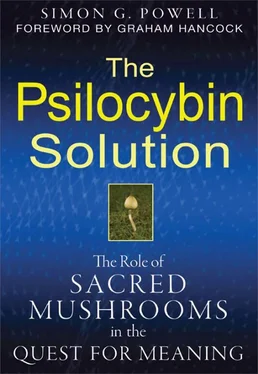First, through their dramatic action within the brain we might come to perceive Nature in an enhanced way. Second, we might come to understand more about the underlying chemistry that is bound up with normal conscious processes, that is, the modus operandi of entheogenic substances reveals the delicate chemical mechanisms that govern consciousness and our perceptions of reality. If, through the use of entheogens, we can enhance our understanding of the interface between the mind and the “world out there,” then we shall know more clearly what consciousness is, how it is formed, and how it can come to experience transcendence. And if the transcendental information accessed in the altered state of consciousness has any truth value—and native shamans all testify to this—then we will be one step closer to an overall conception of what is driving reality. Only then might we apprehend Einstein’s creator and killer, for then we would have begun to establish its ultimate nature. At least it sounds promising.
It is my contention throughout this book that naturally occurring entheogenic plants and fungi are indeed the key to solving the twin mysteries of consciousness and reality. Once ingested, entheogens are intimately involved with the bridge between consciousness and the world around us. The numinous experience that entheogenic agents can induce, no matter how bizarre it might appear in the context of the mundane world and no matter what brain mechanism underlies it, is a real thing; it exists, potentially at any rate. As we shall see, the archetypal tale of transcendence reported by entheogen-using shamans results from direct and verifiable experience.
It is on the basis of such verifiable experience that this book rests. The apparent capacity of the human mind to transcend “normal” reality demands investigation, for it must surely be a tenable step toward reclaiming significance for the existence of human consciousness in the Universe. However, if such an enterprise is spurious and built of no more than ephemeral imagination, then it will only point to the fact that the human imagination under certain chemical circumstances is extraordinarily creative. But it is my belief that entheogenic agents unleash a form of consciousness better able to grapple with the ultimate questions about the reality process than our normal frames of awareness, that they truly offer us a glimpse of some great meaning hitherto the sole domain of the shaman and the mystic, a meaning only alluded to in the conventional religions of the world.
As I see it, if we are genuinely interested in the function of the Universe and the function of human consciousness within it, then we are obliged to follow all and any paths of inquiry. I would suggest that the untrammeled path laid out by entheogenic plants and fungi is, perhaps, the most viable route to evidence that indicates that human consciousness is central to reality. If, instead, this unusual path should prove to lead nowhere, then we may have to accept that human life and human consciousness are devoid of any real purpose, a view proffered, it must be said, by all manner of “experts.” This book can therefore be read as an alternative, user-friendly guide to the nature of reality, the implications of which herald all manner of good news. Very good news indeed.
So stand by for a controversial tale of a recently rediscovered entheogenic substance native to most parts of the Earth’s Temperate Zone. And brace yourself for the astonishing insights into mind and Nature that this substance provokes. Fasten your seat belts, because if I have done my job correctly, you are poised for a roller coaster ride into the very heart of the mystery of existence. As the chapters unfold we will gradually climb up to a peak, from which point we will be propelled through exhilarating vistas in which the significance of consciousness is breathtakingly apparent. By the end of the book, I hope to have shown, beyond any reasonable doubt, that the reality process is essentially smart through and through and that we conscious beings have a privileged role to play in its intentional unfolding. I assure you that this will become crystal clear as the chapters progress.

ONE
Sacred Ground
On May 13, 1957, the well-read pages of Life magazine carried a ground-breaking article that was to profoundly alter the West’s attitude toward the wilder side of the natural world. Here was the first-ever personal account written by a Westerner describing the extraordinary psychological effects induced by a mushroom deified and ritually worshipped by native Mexicans. Consumption of the sacred Mexican mushroom allowed one to contact the gods, experience profound visions, and gain mystical knowledge. Or at least these were the most extravagant of the native Mexican beliefs about the mushroom that were reported by anthropologists during the first half of the twentieth century.
In pre-Columbian times the mysterious mushroom had been known by the Aztecs as “God’s Flesh,” testifying to its divine potency. Such veneration ensured the mushroom a cult status among native Mexicans, despite the violent cultural upheavals wrought by the Spanish Conquest in the sixteenth century. Thus, although the once-mighty Aztec culture was eventually destroyed, the sacred mushroom continued to be used in and around Mexico throughout the Spanish occupation. Yet despite the legendary effects of this peculiar species of fungus, it wasn’t until the middle of the twentieth century that an outside investigator finally consumed the mushroom and hence verified its alleged spiritual potential.
Transmitted solely by word of mouth from the time of the Spanish Conquest, detailed knowledge of the revered mushroom had lain principally in the hands of jealously guarding shamans or native healers, who were loath to disclose their botanical secrets to outsiders. They feared, perhaps justifiably, that the sacred mushroom’s supernatural power would be diminished or be used profanely should the untrustworthy white folk gain full admittance into its living mystery. Therefore the 1957 Life article in which the secret of the mushroom was openly exposed dramatically symbolized the West’s bypassing of this long-standing cultural security system. The sacred mushroom had been forcibly plucked from its localized shamanic niche and was now being presented to the Western world in the form of mass-circulated print, with color photographs and specimen drawings to boot.
Despite exposure to the prying eyes of the West, the status of the Mexican mushroom remained as lofty and as tantalizingly ethereal as ever, more so even since the Western psyche was just as stunned and awed by its transcendental visionary effects as were local Mexicans. In the following decades a psychedelic mushroom cloud of fascination would slowly expand and loom beyond Mexico, eventually extending its magical influence as far away as Europe, but at this initial stage in its sudden growth, the strange mushroom remained a purely Mexican phenomenon.
On the front cover of that auspicious edition of Life magazine, the simple headline read “The Discovery of Mushrooms That Cause Strange Visions,” a rather unusual claim from such a traditionally conservative magazine. The article was included as part of Life magazine’s series of Great Adventures and was written by R. Gordon Wasson, vice-president of a Wall Street banking firm, who, with the aid of his wife, Valentina, had spent some thirty years of part-time research creating a new scientific discipline—ethnomycology, the study of the cultural and historical use of fungi.
Ethnomycology is clearly specialized and seemingly remote from the affairs of modern culture. It was only through the dedicated efforts of the Wassons—who learned of the sacred Mexican mushrooms, sought to find them, and experienced them firsthand—that psilocybin (the as-yet unnamed active constituent of the mushroom, pronounced silla-SIGH-bin) came to the attention of the West. Once the sacred Mexican mushrooms were discovered, ethnomycological science suddenly acquired a distinctly mystical edge, allowing it to breach the domains of religion and psychology. It also provided a new impetus to humankind’s enduring quest to access transcendental knowledge, and there can be no doubt that Wasson’s discovery and vivid description of the effects of psilocybin were crucial in generating the subsequent cultural wave of psychedelic experimentation that soon followed in the 1960s. Moreover, as we shall eventually see, the mushroom also reveals itself as the key to unveiling the secrets of consciousness and the hidden riches of Nature. Theophany, mind, and reality: these three most profound of topics are all met in some way through use of the mushroom. But, before we jump into the deep end, who, pray, was this Wasson fellow, this financiercum-adventurer? And how had he come to penetrate the Earth’s secret psychedelic dimension? Who was he to bring news of sacred fungi to the attention of the Western world?
Читать дальше











